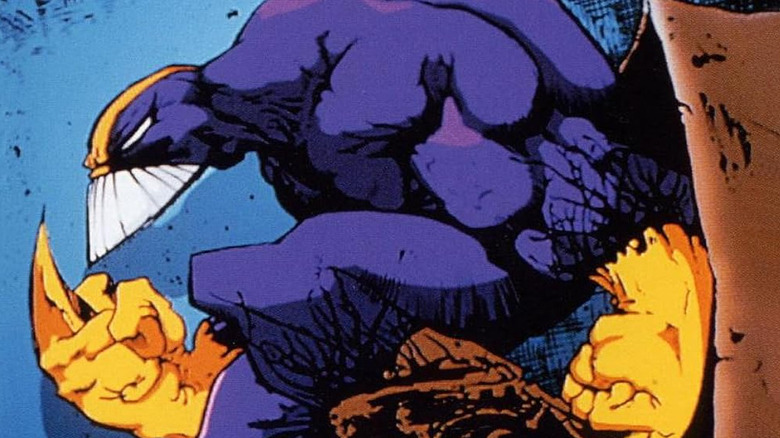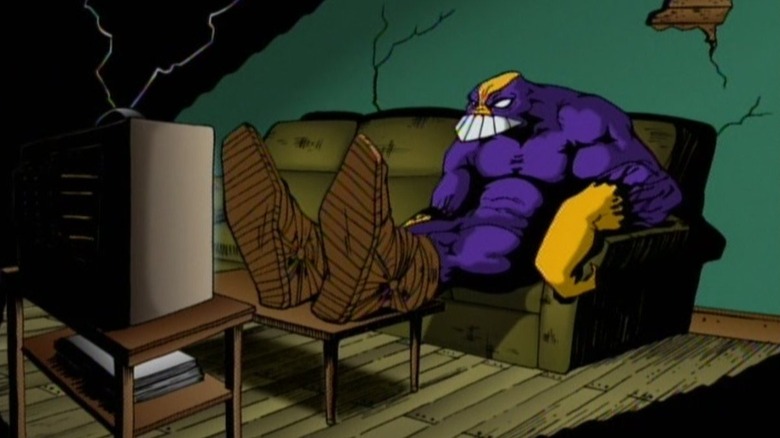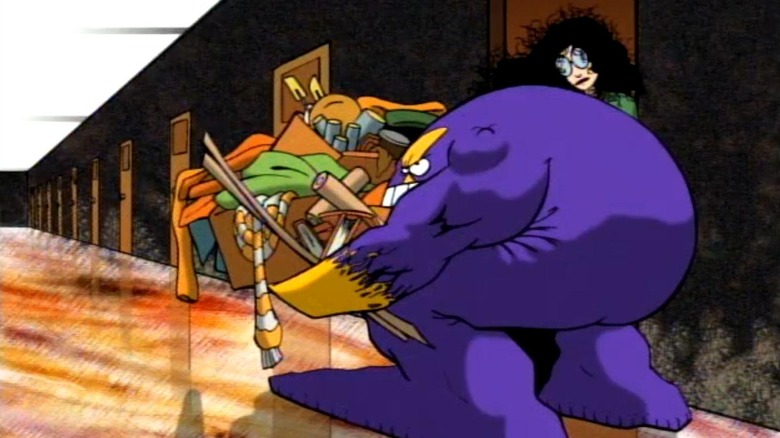MTV's Intense Animated '90s Anti-Superhero Series Was An Antidote To Modern Tropes
The early 1990s were an exciting time for animation. Throughout the 1980s, mainstream commercial cartoons had become, well, commercials, Many of them were owned by toy companies and only put into production to advertise toy products. New cartoon shows wouldn't be greenlit unless they possessed "marquee value," which is to say they were "established IPs" (to use the modern lingo).
This over-commercialization deeply branded a generation, but caused storytelling to suffer. Certain animators sick of the Reagan era began to branch out in the '90s, and the world experienced a sudden explosion of creativity. Animators like John Kricfalusi (whose achievements and gross misconduct alike are chronicled in the documentary "Happy Happy Joy Joy: The Ren & Stimpy Story") and Mike Judge began animating aggressively crude, playfully subversive shows like "The Ren & Stimpy Show" and "Beavis and Butt-head," respectively. Elsewhere, animation exhibitors Spike & Mike began touring theaters with both classic animation titles and their trademark Sick & Twisted series, while "South Park" was on the horizon.
Over on 1990s MTV, the landscape was wide and wondrous. From 1991 to 1995, the network released "Liquid Television," an animation shorts showcase that featured animated works by indie comic artists like Richard Sala, Drew Friedman, Bill Plympton, Charles Burns, Peter Bagge, and many others. "Liquid Television" also marked Mike Judge's debut and featured the first episodes of "Æon Flux."
When "Beavis and Butt-head" proved to be a massive hit, MTV greenlit "The Brother Grunt" along with a two-in-one TV series called "Oddities." The latter swapped back and forth between 11-to-13-minute episodes of two different animated shows, both of them weird and wondrous. It began with "The Head" — a series about a teenager with an alien parasite living in his skull, causing his head to grow six feet taller — and was rounded out by "The Maxx," an adaptation of the Image Comics title created by Sam Keith.
"The Maxx," in particular, was ostensibly a superhero show but subverted the genre's tropes at every turn. Instead, it was far more interested in rampant misogyny, the cycles of trauma we visit on others, and the psychological damage wrought by sexual assault.
The Maxx was a weird, semi-surreal addition to MTV's programming
"The Maxx" took the panels from Keith's comic book, and, in many cases, merely transposed them directly to the screen with only a little bit of animation. Some sequences, however, were elaborately animated. With the exception of maybe two brief scenes, the writing on "The Maxx" was quoted almost verbatim from the comics. The titular superhero (Michael Haley) wore a large toothy mask, a purple bodysuit, and elaborately wrapped cloth shoes. His middle fingers had hardened into points, allowing him to wield them like claws. The Maxx, however, was no vigilante; he was a mentally ill homeless man who slept in cardboard boxes, had a constant pounding noise in his head, and only occasionally murdered muggers.
Occasionally, the Maxx would vanish into an alternate dimension that he assumed was the Australian Outback. It was populated by unusual fantasy creatures, including little bipedal, eyeless piranha creatures called Isz. In the Outback, it was the Maxx's job to protect a Frank Frazetta-esque fantasy demigoddess whom he referred to as the Leopard Queen.
The Leopard Queen happened to resemble a social worker the Maxx was friends with back in the real world. Her name was Julie Winters (Glynnis Talkin), and she gradually evolved into the protagonist of the series. Julie was bitter, wounded, and still recovering from a sexual assault from about a year earlier when the evil sorcerer Mr. Gone (Barry Stigler), who controls an army of dark Isz he somehow transported from the Maxx's Outback world, came into her life.
Mr. Gone, as we eventually learned, was the man who had assaulted Julie. His tinkering with magic, however, caused Julie's trauma to open the Outback fantasy world, a place where she could escape and be powerful as the Leopard Queen. The Maxx had interfered as the sex crime was being committed and was unwittingly transformed into a none-too-bright savior figure in the process.
The Maxx was a superhero show that dispensed with the superheroism
Both the "Maxx" comics and animated series dispensed with any pretense that they were a superhero project from day one. Sure, there was technically a costumed vigilante who had sworn to protect a princess, but the story was more about the scars left behind by a serial victimizer. How do women survive in the wake of being so deeply hurt? And why do rapists think the way they do? It's a rough-hewn, mature drama that just happens to have bizarro creatures and semi-surreal visuals. The animation, mind you, frequently changed styles; some scenes featured elaborate hand-drawn landscapes, while others were composed of still images and rudimentary CGI.
Despite the heady subject matter, though, "The Maxx" was also strangely whimsical at times. Its showrunners never lost sight of the fact that the Maxx looked silly and that comic book wizardry is ridiculous when juxtaposed with real-world crimes. As a whole, the series occupied a peculiar middle-space between adolescent superhero fantasies and assertive post-feminist musings about the nature of sexual power.
Notably, though, the "Maxx" TV show wasn't as elaborate or complex as Keith's original 35-issue comic book narrative. After only one season and 13 episodes, the series went off the air — not because it was badly reviewed or drew low ratings, but because it only needed that much time to run its course. The show was later released on VHS and DVD, allowing it to gather a passionate cult following.
Back in 2019, Channing Tatum was actually attached to star in a "Maxx" feature film. Unfortunately, the project would thereafter fall into development hell, which isn't all that surprising. "The Maxx" was decidedly of its era, embracing stylistic flourishes and tones that only Gen-Xers were used to. We can always look back and marvel at it, though.


